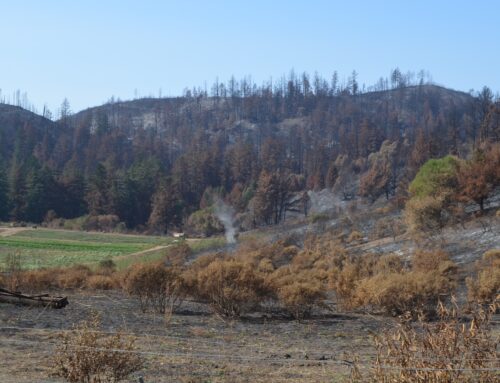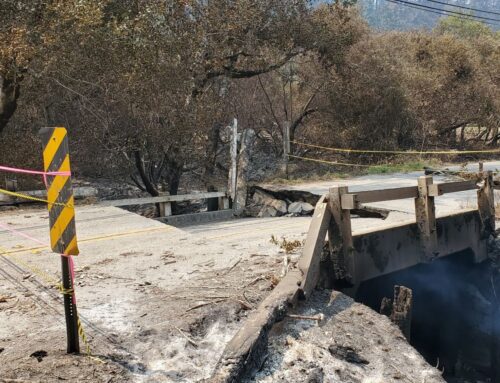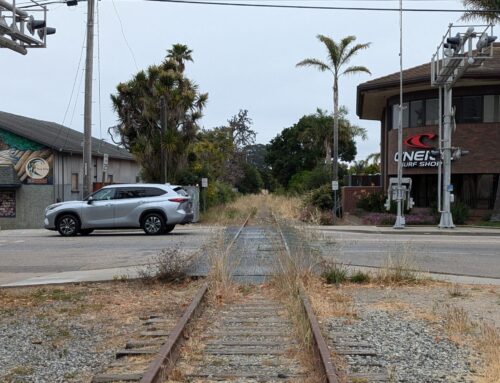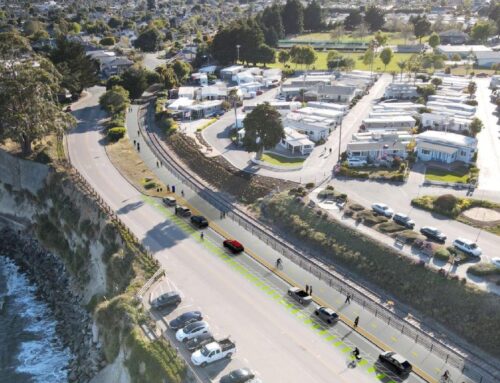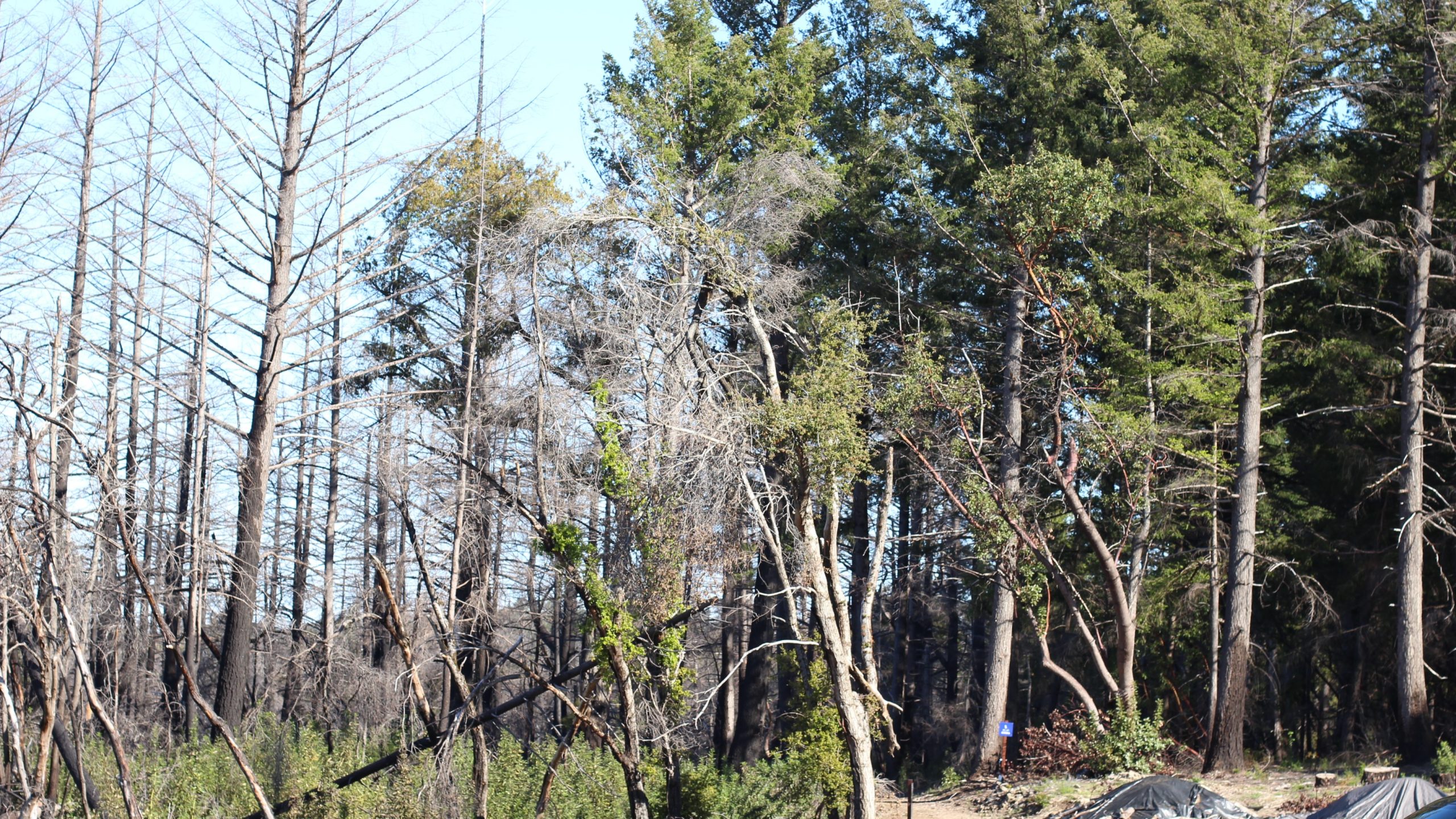
The edge of a fuel break in San Vicente Redwoods in May 2023 shows the difference between part of the forest burned by foresters six months before the CZU Lightning Complex Fire (right) and untreated forest decimated by the fire (left). (Jesse Kathan — Santa Cruz Local)
SANTA CRUZ >> To prepare for a potentially disastrous fire season on the Central Coast, state and local leaders have focused on forest management: controlled burns and removal of brush, dead trees and other fuel.
This year’s historic rainfall has brought moist soils and green grass to much of the state, and this year’s fire season could be delayed, said Cal Fire Director and Fire Chief Joe Tyler. But once the green slopes turn gold, “that grass is going to be easily ignitable.”
Tyler spoke at the sixth meeting of the California Wildfire and Forest Resilience Task Force, held May 11 at Boardwalk’s Cocoanut Grove. The task force, formed by Gov. Gavin Newsom, created a plan in 2021 to improve management of the state’s public and private forests and increase collaboration between public agencies, scientists, tribal governments and landowners.
Work to make California’s forests more resilient to fire has been bolstered by billions of dollars in funding from the state and federal government, said California Natural Resources Agency Secretary Wade Crowfoot.
“Tremendous progress has been made,” said Crowfoot. “But we know so much more work is needed.”
California agencies have ramped up forest management efforts in recent years, said task force Director Patrick Wright during the meeting. Since 2021, agencies and landowners on the Central Coast have completed:
- 32,000 acres of fuel reduction. Those efforts involve removing shrubs, low-lying branches, and dead trees.
- 23,000 acres of prescribed fires.
Although agencies across the Central Coast are trying to increase these operations, they face numerous challenges:
- Grant-based funding often favors smaller projects, rather than large-scale, long-term efforts, said Anne Crealock, planning and program manager for the Marin Wildfire Prevention Authority.
- Regulations, including rules from regional air quality boards and permit requirements of the California Environmental Quality Act, make prescribed burn programs costly and logistically difficult, said Nadia Hamey, property manager of San Vicente Redwoods. San Vicente Redwoods is a nearly 9,000-acre forest west of Bonny Doon.
- The state has a small number of “burn bosses” trained to conduct prescribed burns, and many of those burn bosses struggle to purchase insurance for their burns, said Devii Rao, a University of California Cooperative Extension advisor who works with the Central Coast Prescribed Burn Association.
Controlled burns
Throughout the state, forest managers are using low-intensity fires to eliminate fuel in forests that haven’t burned for decades. Small, frequent fires — from natural ignitions and indigenous stewards — have historically been key to the health of California’s forests.
San Vicente Redwoods contains a stark example of the power of healthy fire. The privately-owned forest is managed by a partnership of Peninsula Open Space Trust and other nonprofits. Adjacent to Empire Grade Road, the recently-opened Hu’-mĭs trail seems to separate two forests.
East of the trail, uphill to Empire Grade Road, a green canopy of oak and madrone trees tower over an understory of shrubs. To the west, blackened trunks stand like obelisks. Both areas, along with most of San Vicente Redwoods, burned in the 2020 CZU Lightning Complex Fire. But the intact canopy marks the success of strategies that could save other pieces of forest in the future.
The area uphill of the trail was developed as a “shaded fuel break,” an area of the forest managed to be less flammable. In 2012, managers cut shrubs and low-lying tree limbs and burned them in small piles. In February 2020, they used drip torches to light a controlled burn on the forest floor.
Six months later, after the CZU fire, the fuel break was one of the only pockets of forest left intact. “The fire just skipped right over,” said Hamey during a field presentation for attendees of the task force meeting.
The site is just one example of what scientists and forest managers are trying to expand across San Vicente Redwoods and the entire Central Coast.
“We’re really aspirational about really ramping up the prescribed burning,” said Justin Garland, Redwoods Program Manager for Peninsula Open Space Trust. “We really see it as a cost effective, efficient, ecologically important way to maintain the fuels out here.”
California State Parks has also tried to increase prescribed burns, said Chris Spohrer, State Parks Santa Cruz district superintendent, during the task force meeting. Last year, the agency partnered with the Central Coast Prescribed Burn Association to add more fires at Wilder Ranch State Park. “We have been burning there for years,” he said. “But this last year, we probably tripled the amount of prescribed fire that we could do there, because we had help.”
Agencies throughout the Central Coast have also partnered with the Amah Mutsun Tribal Band to perform “cultural burns” — small, controlled burns that include traditional prayers and ceremonies. Indigenous people in the northern Monterey Bay area spoke the Awaswas language for many generations. They were violently forced from their land and into Spanish missions in the 18th and 19th centuries, said Valentin Lopez, chair of the Amah Mutsun. There are no survivors of the Awaswas-speaking people, he said. The Amah Mutsun, whose traditional territory includes lands in the central Monterey Bay area, are now returning native land stewardship to the area. “We work to restore sacredness to the lands and to ensure the Awaswas-speaking people are honored,” he said during the meeting.
Removal of dead trees
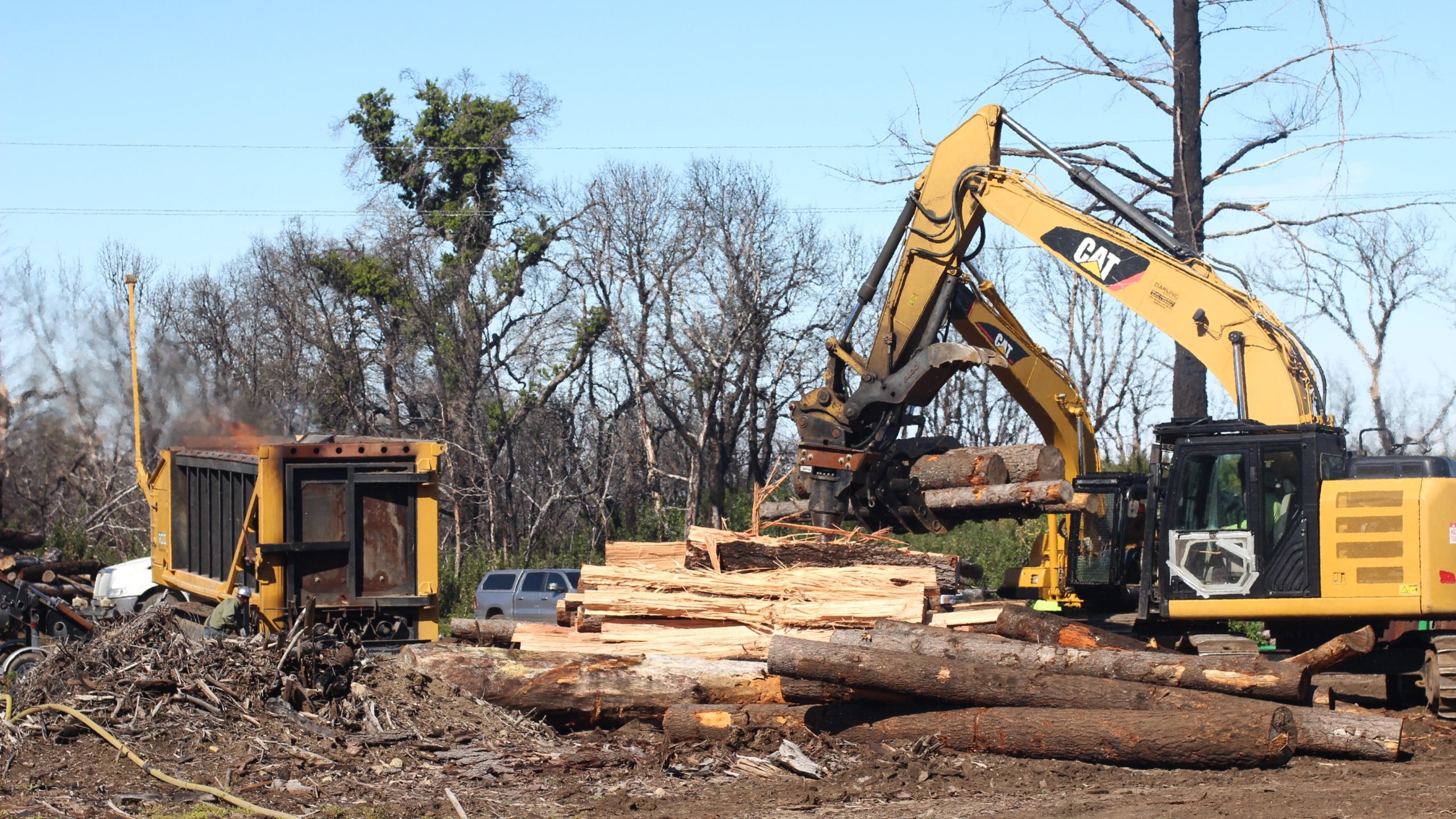
Dead trees dragged from the fuel break in San Vicente Redwoods are split and burned in a carbonator in May 2023. (Jesse Kathan — Santa Cruz Local)
The area decimated by the CZU fire is especially vulnerable to another fire, multiple leaders said. The burn scar left tens of thousands of acres of standing dead trees like those in San Vicente Redwoods. Some of those trees fell in this year’s storms and were carried by coastal creeks out to sea. Those same trees battered the coast during high ocean swells, said Santa Cruz County Supervisor Zach Friend during the meeting.
“In less than two years, we’ve experienced some of the worst climate-related disasters here in our community that we’ve seen within our history,” he said. “One of the things that I think is important for the working group, and those that are attending today to recognize is the interrelationship between these climate disasters.”
If those trees are left standing, they could fuel the next wildfire, said Cal Fire CZU Division Chief Rich Sampson.
Hauling out all the dead trees isn’t feasible. But forest managers have removed about 5,000 tons of dead wood near Empire Grade Road in San Vicente Redwoods, in hopes that it could slow the next fire’s progress. Of the more than 86,000 acres burned in the CZU fire, “this is a drop in the bucket,” Sampson said.
Most of the removed wood isn’t marketable as firewood or lumber, and transporting it is extremely expensive, said Sampson. Instead, it’s burned in metal boxes that limit the escape of smoke and emissions. One kind of unit, a curtain burner, uses a fan over the top to contain smoke. Another, called a carbonator, creates biochar, a charcoal-like substance that retains most of the carbon from the tree and can be used in agriculture or restoration of contaminated soils.
Central Coast challenges
Adapting to fire will require homeowners to prioritize fire-safe retrofits, even if they’re costly, said Chris Dicus, a fire scientist from San Luis Obispo. While many people along the coast assume that fog moisture will protect them from a severe fire, all communities are vulnerable, he said. Urban communities with dense housing could be especially at risk, as fire can jump from house to house.
“I look at this not as a forest fire problem, or a shrub fire problem, but a houses-burning-down problem,” Dicus said. “So we have to, in my opinion, start at the house.”
As the climate changes, the Central Coast is expected to see more intense droughts and could lose much of the fog that sustains redwood forests, said Virginia Matzek, a Santa Clara University ecologist during the task force meeting.
Drier conditions will create a more flammable landscape, and fuel left from decades of fire suppression makes fires even more intense, she said.
Another challenge on the Central Coast is a poor road network that leaves many communities with only one or two evacuation routes, which can quickly become clogged. “We want to get people out,” said Dicus. “That’s our first choice, but that can not be our only choice.”
Evacuation plans should also include safe refuges such as community centers and parks where residents can stay safe from wildfire without having to drive long distances, he said.
Despite the challenges, the task force roadmap could lead to a future without megafires like the CZU fire, Crowfoot from the California Natural Resources Agency said during the meeting.
“Fully seven percent of our state’s landmass has burned in the last few years, and we know we will be challenged with this in years and decades to come,” Crowfoot said.
Crowfoot later added that the state has more funding, tools and collaboration for wildfire protection than ever before. “I am fully optimistic that we will get to a point in California where we have got this catastrophic wildfire risk under control.”
Questions or comments? Email [email protected]. Santa Cruz Local is supported by members, major donors, sponsors and grants for the general support of our newsroom. Our news judgments are made independently and not on the basis of donor support. Learn more about Santa Cruz Local and how we are funded.
Jesse Kathan is a staff reporter for Santa Cruz Local through the California Local News Fellowship. They hold a master's degree in science communications from UC Santa Cruz.


